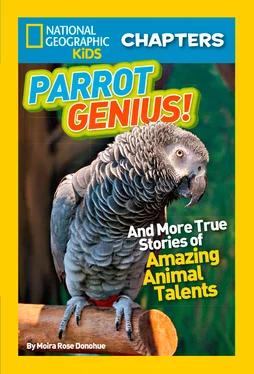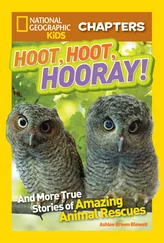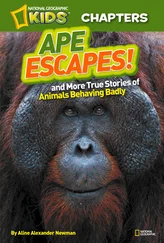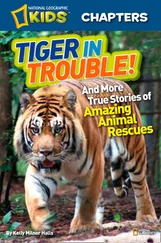Moira Donohue - National Geographic Kids Chapters - Parrot Genius - And More True Stories of Amazing Animal Talents
Здесь есть возможность читать онлайн «Moira Donohue - National Geographic Kids Chapters - Parrot Genius - And More True Stories of Amazing Animal Talents» — ознакомительный отрывок электронной книги совершенно бесплатно, а после прочтения отрывка купить полную версию. В некоторых случаях можно слушать аудио, скачать через торрент в формате fb2 и присутствует краткое содержание. Жанр: unrecognised, на английском языке. Описание произведения, (предисловие) а так же отзывы посетителей доступны на портале библиотеки ЛибКат.
- Название:National Geographic Kids Chapters: Parrot Genius: And More True Stories of Amazing Animal Talents
- Автор:
- Жанр:
- Год:неизвестен
- ISBN:нет данных
- Рейтинг книги:3 / 5. Голосов: 1
-
Избранное:Добавить в избранное
- Отзывы:
-
Ваша оценка:
- 60
- 1
- 2
- 3
- 4
- 5
National Geographic Kids Chapters: Parrot Genius: And More True Stories of Amazing Animal Talents: краткое содержание, описание и аннотация
Предлагаем к чтению аннотацию, описание, краткое содержание или предисловие (зависит от того, что написал сам автор книги «National Geographic Kids Chapters: Parrot Genius: And More True Stories of Amazing Animal Talents»). Если вы не нашли необходимую информацию о книге — напишите в комментариях, мы постараемся отыскать её.
National Geographic Kids Chapters: Parrot Genius: And More True Stories of Amazing Animal Talents — читать онлайн ознакомительный отрывок
Ниже представлен текст книги, разбитый по страницам. Система сохранения места последней прочитанной страницы, позволяет с удобством читать онлайн бесплатно книгу «National Geographic Kids Chapters: Parrot Genius: And More True Stories of Amazing Animal Talents», без необходимости каждый раз заново искать на чём Вы остановились. Поставьте закладку, и сможете в любой момент перейти на страницу, на которой закончили чтение.
Интервал:
Закладка:
• Most parrots are brightly colored. Macaws (sounds like muh-KAWS) are some of the most colorful.
• All parrots have curved beaks.
• Most parrots eat seeds and fruit. Some eat flowers and bugs.
• Parrots have four toes on each foot. Two toes point forward and two point backward.
• The biggest parrots are the macaw (left) and the large cockatoo.
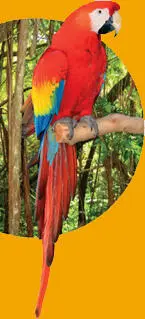
The trainers at the Knoxville Zoo put Einstein in her new home. They knew that like some people, parrots can be afraid of new places. But Einstein wasn’t an ordinary parrot. She was curious. She checked out the parrot cage. It was big enough to hold a couple of large dogs. She saw that it had several perches, or branches. It also had three bowls. One was for water. Another was for food—berries and seeds. The third bowl was empty. Soon Einstein would find out what it was for.
In no time, Einstein made herself at home. Zoo trainers put toys in her cage. They gave her shiny beads to play with. They gave her bells to ring. Sometimes they hid food inside tubes. She liked to figure out how to get the food out!
It didn’t take the zoo long to decide that Einstein would be good in the show. But she had to be trained. Scientists say that African grays are as smart as five-year-old children. But they behave like two-year-olds. That meant Einstein had a lot to learn.
Teresa Collins became her first head trainer at the zoo. Teresa knew the first thing Einstein needed to learn was to trust her. So she dropped treats into the third bowl in Einstein’s cage whenever she walked by. Sometimes she tossed a peanut into the treat bowl. That was the best. Einstein loved peanuts! Einstein soon learned that Teresa made good things happen.
After a while, Teresa tried something new. Instead of dropping a treat into the bowl, she pinched the food between her fingers. She held it out to Einstein. African gray parrots have strong beaks. Teresa wanted Einstein to take the food gently. Einstein had learned that Teresa was her friend. She knew better than to bite the hand that fed her.
One day, Teresa put her hand into Einstein’s cage. She hoped Einstein would climb onto it. It would mean that Einstein trusted her. Trusting a human can take time, so it’s a big step for a parrot. But not for Einstein. Einstein went to Teresa right away. She even let Teresa pet her chest.
Did You Know?
Sometimes African gray parrots will shrink the pupils in their eyes, bob their heads, stretch their necks, and throw up. It’s a sign that they love you!
Now Einstein was ready to learn some new words. How quickly would she learn? Teresa wondered. We say that African gray parrots “talk.” But actually, they mimic, or copy, sounds. They have a lot of muscles (sounds like MUH-sels) in their necks. They use them to change how the air goes through their throats. That makes different sounds. It’s kind of like playing a flute.
African grays can make 2,000 different sounds. It’s fun for them. But it also protects them. In the wild, some large birds, like hawks, owls, and eagles, feed on parrots. If one grabs an African gray, the bird makes a loud noise. Screech! The large bird lets go of the parrot. Imagine you are about to take a bite of pizza. Suddenly, it screams. You’d drop it pretty fast, too!
Teresa wanted Einstein to copy her. She would speak a word to Einstein. Sometimes Einstein said the word right away. Sometimes Teresa had to repeat it over and over. Teresa discovered that Einstein liked saying lots of words. But sometimes she refused to repeat a word. Parrots will only make sounds they like.
Einstein didn’t copy just the sounds her trainers made. She copied any sound she liked. She loved the sound of water running. So she taught herself that sound. Once she heard an embarrassing sound. Oops. Someone passed gas. Einstein copied that sound too. Maybe she needs to learn, “Excuse me!”
Parrots can feed themselves with their feet. But this brainy bird can do a whole lot more!
One day Teresa had a brainstorm. Einstein lived in a zoo with all kinds of animals. Would the parrot enjoy making animal sounds? Teresa wondered. So Teresa howled like a wolf. “ Aaooo!”
“ Aaooo!” Einstein howled back.
“ Whoo, whoo, whoooo!” Teresa hooted like an owl.
“ Whoo, whoo, whoooo!” Einstein hooted back. Einstein loved to imitate animal sounds.
After a while, Teresa decided to teach Einstein to make these sounds “on cue.” That means making a sound in response to a question. It was harder to teach—and to learn!
First, Teresa waited for Einstein to copy a sound, like “meow.” She gave Einstein a treat. Then she asked a question. “What does a cat say?” When Einstein said “meow” again, she got another treat. This time she got a big treat—a peanut! Teresa did this over and over. Soon Einstein said “meow” whenever Teresa asked her what a cat said.
One time Einstein heard a funny sound and started repeating it. It sounded like “ Arrgh.” It made her trainer think of a pirate. Pirates often had colorful parrots on their shoulders. So her trainer said, “What do pirates say?”
Did You Know?
Crows are also very intelligent birds. They can make and use tools. One crow was filmed making a wire hook to get food!
“ Arrgh,” said Einstein. Teresa and Einstein said it over and over. In just a couple of hours, Einstein had a new sound on cue!
Teresa and the other trainers picked out new sounds for Einstein to learn. When they agreed on one, they would all say it to her whenever they saw her. Before long, Einstein could make 200 sounds, including many animal noises! That’s more than almost any other parrot, even other African grays.
Einstein stood out because she knew a lot of sounds. And she learned fast. But there are other parrots that can make a lot of sounds. What makes Einstein extra special is that she remembers sounds on cue. Most other parrots can only remember 13 or 14 sounds on cue at a time. But that’s not how Einstein’s brain works. She doesn’t forget old cues when she learns new ones. Einstein knows 85 words on cue. She really is amazing!
Does Einstein understand what she’s saying? Her trainers say that’s a hard question to answer. Sometimes the parrot says something that isn’t right. One time, her trainer said, “Make an evil laugh.” Usually Einstein says, “ Nyah-ah-ah.” But this time, Einstein said, “I love you.”
But sometimes she says things that make a lot of sense, even if she isn’t given a cue. One day a trainer was eating in front of her. “What are you doing?” Einstein asked. She cocked her head. She was looking for a treat. When the trainer didn’t give her one, she said, “ Mmmmm,” like we say when something tastes really good. No one taught her that! Soon she started doing it whenever a trainer was eating. She was training her trainer to give her a treat!
Once Einstein didn’t get a treat when she said “ Mmmmm.” To get her trainer’s attention, she lay on her back in her cage. She stuck her feet in the air. She looked right at her trainers. “What are you doing, sweetheart?” she asked. Her trainers thought she was complaining because she wasn’t getting a treat. They laughed really hard and gave her one.
Dr. Irene Pepperberg, a scientist, believes that parrots understand language. She wanted to prove her idea. She had a parrot, an African gray parrot named Alex. She trained him and studied him for 30 years. Alex learned over 150 words. And he showed signs of understanding language. So maybe when Einstein seems to understand, she really does!
Читать дальшеИнтервал:
Закладка:
Похожие книги на «National Geographic Kids Chapters: Parrot Genius: And More True Stories of Amazing Animal Talents»
Представляем Вашему вниманию похожие книги на «National Geographic Kids Chapters: Parrot Genius: And More True Stories of Amazing Animal Talents» списком для выбора. Мы отобрали схожую по названию и смыслу литературу в надежде предоставить читателям больше вариантов отыскать новые, интересные, ещё непрочитанные произведения.
Обсуждение, отзывы о книге «National Geographic Kids Chapters: Parrot Genius: And More True Stories of Amazing Animal Talents» и просто собственные мнения читателей. Оставьте ваши комментарии, напишите, что Вы думаете о произведении, его смысле или главных героях. Укажите что конкретно понравилось, а что нет, и почему Вы так считаете.
